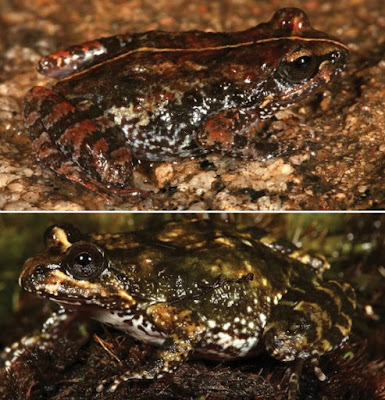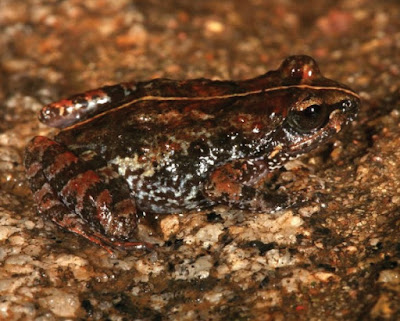[Most Recent Entries] [Calendar View]
Sunday, February 25th, 2018
| Time | Event | ||||
| 9:51a | [Botany • 2018] Acantholimon ibrahimii • A New Species of A. section Staticopsis (Plumbaginaceae) from the Mediterranean Part of Turkey
Abstract A new species, Acantholimon ibrahimii Akaydın, is described, illustrated and discussed in comparison with its close relative A. davisii. The new species is distinguished from the latter species mainly by the generative organs (namely the inflorescence types and petals colour), habitat type and ecological behaviour. Data are also reported on the conservation status of A. ibrahimii, which is suggested to be labelled as EN according to the IUCN categories. Furthermore, a revised key to the Turkish Acantholimon species of A. sect. Staticopsis with spike laxly distichous and scape much longer than leaves is presented. Keywords: Acantholimon, A. sect. Staticopsis, conservation, endemism, Staticoideae, taxonomy, Eudicots Galip Akaydın. 2018. Acantholimon ibrahimii (Plumbaginaceae), A New Species of A. section Staticopsis from the Mediterranean Part of Turkey. Phytotaxa. 340(1); 48–54. DOI: 10.11646/phytotaxa.340.1.2 | ||||
| 10:39a | [Herpetology • 2018] Nothophryne baylissi, N. inagoensis, N. ribauensis & N. unilurio • New Species of Mongrel Frogs (Pyxicephalidae: Nothophryne) for northern Mozambique Inselbergs
ABSTRACT Nothophryne Poynton, 1963 is a monotypic genus of frog, with the nominal species N. broadleyi found only on Mount Mulanje, in southern Malawi. Recent surveys in northern Mozambique, however, have uncovered at least four new species associated with four inselbergs (Mount Inago, Mount Namuli, Mount Ribáuè and Taratibu Hills). Previous phylogenetic analyses using mitochondrial genes suggest that each mountain isolate has an endemic species of Nothophryne. Herein we provide a rediagnosis of the genus and comparative diagnoses of four new species based on new material. KEYWORDS: Africa, amphibian, inselbergs, Pyxicephalidae, species, taxonomy Nothophryne broadleyi Poynton, 1963 Mongrel Frog; Broadley’s Mountain Frog Nothophryne baylissi sp. nov. Namuli Mongrel Frog; Namuli Mountain Frog Etymology—We name this species in honour of Dr Julian Bayliss who was the first to document this unique species of frog from the slopes of Mount Namuli, during the Kew Gardens-Darwin Initiative expedition to these inselbergs (Timberlake et al. 2009). Distribution— Currently only known from Mount Namuli in central Mozambique. Nothophryne inagoensis sp. nov. Inago Mogrel Frog; Inago Mountain Frog Etymology—The new species is named after Mount Inago, where this species is endemic. Distribution—Currently only known from Mount Inago in central Mozambique.
Nothophryne ribauensis sp. nov. Ribáuè Mongrel Frog; Ribáuè Mountain Frog Etymology—The new species is named after Mount Ribáuè, from which it is currently only known from both Mount Ribáuè and Mount M’pàluwé section of the massif. Distribution—Currently only known from Mount Ribáuè in central Mozambique. Nothophryne unilurio sp. nov. Quirimbas Mongrel Frog; Quirimbas Mountain Frog Etymology—Named after Lúrio University, Pemba, Mozambique where Harith Farooq is Director of the Natural Sciences Faculty. The composition comprise out of uni for University and lurio for Lúrio Distribution— Currently only known from low lying inselbergs in north eastern Cabo Delgado Province of Mozambique. The type locality is situated ..., in the Quirimbas National Park. Werner Conradie, Gabriela B. Bittencourt-Silva, Harith M. Farooq, Simon P. Loader, Michele Menegon and Krystal A. Tolley. 2018. New Species of Mongrel Frogs (Pyxicephalidae: Nothophryne) for northern Mozambique Inselbergs. African Journal of Herpetology. DOI: 10.1080/21564574.2017.1376714 CONRADIE, W., G.B. BITTENCOURT-SILVA, H.M. ENGELBRECHT, S.P. LOADER, M. MENEGON, C. NANVONAMUQUITXO, M. SCOTT, & K.A. TOLLEY. 2016. Exploration into the hidden world of Mozambique’s sky island forests: new discoveries of reptiles and amphibians. Zoosystematics and Evolution. 92(2): 163–180. DOI: 10.3897/zse.92.9948 | ||||
| 4:03p | [Herpetology • 2018] Tupinambis matipu • A New Species of Tupinambis Daudin, 1802 (Squamata: Teiidae) from Central South America
Abstract We describe a new species of Tupinambis from central South America in a transitional region between Amazonia, Cerrado, and Pantanal. The new species differs from its congeners by the number of femoral pores, posterior gulars, and mesoptychial scales and by color pattern. It is partially sympatric with Tupinambis cuzcoensis, Tupinambis longilineus, Tupinambis quadrilineatus, and maybe also with Tupinambis teguixin, but in general terms they tend to substitute one another in space.
Tupinambis matipu sp. nov. Etymology.— The specific epithet, matipu, is a noun in apposition and refers to the indigenous people Matipu, whose village lies at about 125 km west of the type locality, on the southern portion of Parque Indı´gena do Xingu, Mato Grosso state, Brazil. By 2011, they numbered only 149 persons according to the Instituto de Pesquisa Etno-Ambiental do Xingu/Ipeax (Ricardo and Ricardo, 2011). Marcélia B. Silva Marco A. Ribeiro-Júnior and Teresa C. S. Ávila-Pires. 2018. A New Species of Tupinambis Daudin, 1802 (Squamata: Teiidae) from Central South America. Journal of Herpetology. 52(1); 94-110. DOI: 10.1670/16-036 Resumo: Descrevemos uma nova espécie de Tupinambis da região central da América do Sul, em uma área de transição entre Amazônia, Cerrado e Pantanal. A nova espécie difere das congêneres pelo número de poros femorais, escamas gulares posteriores, escamas entre as dobras antegular e gular, e padrão de coloração. É simpátrica com Tupinambis cuzcoensis, T. longilineus, T. quadrilineatus e tavez também com Tupinambis teguixin, mas em termos gerais essas espécies tendem a se substituir geograficamente. |
| << Previous Day |
2018/02/25 [Calendar] |
Next Day >> |








